-
 Bitcoin
Bitcoin $107,443.3008
-1.17% -
 Ethereum
Ethereum $2,494.2503
-0.63% -
 Tether USDt
Tether USDt $1.0003
0.00% -
 XRP
XRP $2.2496
2.23% -
 BNB
BNB $658.7569
0.63% -
 Solana
Solana $154.9826
1.94% -
 USDC
USDC $1.0000
0.01% -
 TRON
TRON $0.2799
1.07% -
 Dogecoin
Dogecoin $0.1659
-1.78% -
 Cardano
Cardano $0.5745
0.25% -
 Hyperliquid
Hyperliquid $39.7005
0.13% -
 Bitcoin Cash
Bitcoin Cash $519.5989
3.78% -
 Sui
Sui $2.7874
-2.40% -
 Chainlink
Chainlink $13.3762
-1.69% -
 UNUS SED LEO
UNUS SED LEO $9.0784
-0.64% -
 Avalanche
Avalanche $17.9846
-2.81% -
 Stellar
Stellar $0.2390
-0.06% -
 Toncoin
Toncoin $2.9028
0.25% -
 Shiba Inu
Shiba Inu $0.0...01147
-2.17% -
 Litecoin
Litecoin $86.6956
-1.27% -
 Hedera
Hedera $0.1508
-0.50% -
 Monero
Monero $322.6222
3.26% -
 Polkadot
Polkadot $3.4124
-2.99% -
 Dai
Dai $0.9999
0.00% -
 Bitget Token
Bitget Token $4.5434
-1.97% -
 Ethena USDe
Ethena USDe $1.0002
0.00% -
 Uniswap
Uniswap $7.1562
-2.61% -
 Aave
Aave $275.8830
-1.02% -
 Pepe
Pepe $0.0...09790
-4.04% -
 Pi
Pi $0.5018
-5.09%
Is the monthly long lower shadow + weekly volume and price rise suitable for mid-term layout?
A monthly long lower shadow candlestick pattern suggests potential bullish reversal, especially when confirmed by rising weekly volume and price action.
Jul 01, 2025 at 01:29 am
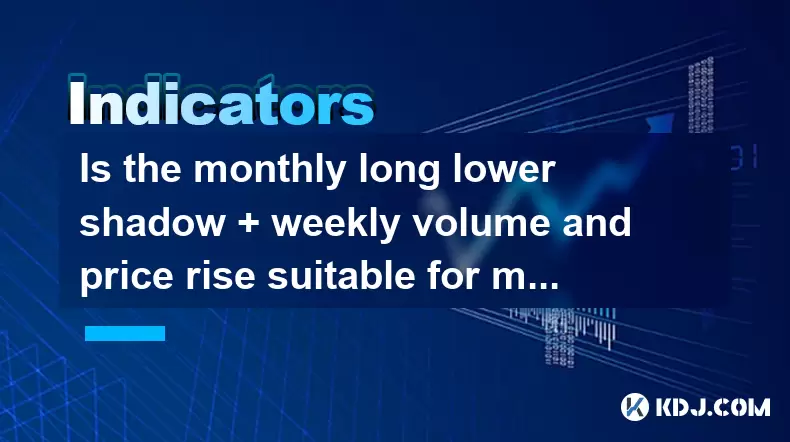
Understanding the Monthly Long Lower Shadow Pattern
A monthly long lower shadow candlestick pattern occurs when the price of a cryptocurrency drops significantly during the month but then rebounds to close near or above the opening price. This creates a candle with a long wick below and a relatively small body. In technical analysis, this pattern is often interpreted as a sign of potential bullish reversal, especially if it appears after a prolonged downtrend.
The long lower shadow indicates that bears attempted to push prices down, but strong buying pressure returned the price to higher levels by the end of the month. This suggests that support may be forming at these lower levels, making it an attractive entry zone for mid-term traders. However, relying solely on this signal can be misleading without confirmation from other timeframes or indicators.
Important:
A monthly long lower shadow should not be taken in isolation; always cross-reference with weekly and daily charts to confirm trend strength and momentum.Weekly Volume and Price Rise: Confirming Strength
When analyzing the weekly chart, rising volume alongside increasing price action serves as a powerful confirmation tool. If a weekly volume surge coincides with a significant price rise, it suggests institutional or large-scale accumulation is taking place. This combination often signals that buyers are stepping in with conviction, which supports the idea of a new uptrend beginning.
Volume plays a crucial role because it confirms whether price movements are sustainable. For example, if the price rises sharply on low volume, it could indicate a false breakout or short-lived rally. Conversely, a price rise supported by expanding weekly volume typically shows real demand and improved market sentiment.
- High volume during a weekly up move reinforces the validity of the trend.
- Price breaking key resistance levels on strong volume increases the likelihood of continuation.
- Divergence between volume and price can warn of weakening momentum.
In the context of a monthly long lower shadow, a subsequent weekly volume and price rise enhances the probability of a successful mid-term trade setup.
Combining Monthly and Weekly Signals for Mid-Term Entry
For mid-term investors or swing traders, combining both the monthly long lower shadow and weekly volume and price rise can provide a high-probability entry point. The strategy involves identifying a potential bottom formation on the monthly chart and waiting for confirmation via weekly momentum and volume.
Here’s how to approach it step-by-step:
- Look for a monthly candle with a long lower shadow following a downtrend.
- Check if the weekly chart begins showing signs of recovery — higher highs and higher lows.
- Ensure that volume on the weekly chart is rising alongside price movement.
- Wait for a breakout above key resistance levels on the weekly timeframe before entering a position.
- Use moving averages (like the 50-week EMA) as dynamic support zones for better risk management.
This layered approach helps filter out false signals and aligns multiple timeframes, increasing the confidence level in the trade.
Risk Management Considerations
Even when combining strong technical signals like the monthly long lower shadow and weekly volume and price rise, risk management remains critical. Cryptocurrency markets are highly volatile, and no pattern guarantees success.
To protect capital and optimize outcomes:
- Set a stop-loss order below the monthly long lower shadow low to limit downside exposure.
- Position size should reflect the volatility of the asset and your personal risk tolerance.
- Monitor on-chain metrics such as exchange inflows/outflows or whale activity for additional insights.
- Be cautious of news events or macroeconomic data that could override technical setups.
Using tools like ATR (Average True Range) can help determine appropriate stop-loss distances based on current volatility conditions.
Practical Example Using Historical Data
Let’s consider a historical example using Bitcoin (BTC) in early 2019:
- BTC formed a monthly long lower shadow in December 2018, indicating potential exhaustion of the downtrend.
- In Q1 2019, the weekly chart showed rising volume and consistent price gains, confirming the shift in sentiment.
- A breakout above $4,000 occurred in February 2019, supported by increased volume and positive momentum.
- Traders who entered around that area benefited from a multi-month rally reaching nearly $13,000 by June 2019.
This case demonstrates how aligning monthly and weekly signals can lead to profitable mid-term opportunities.
Another example is Ethereum (ETH) in late 2022, where a similar pattern emerged post-Fall crash. ETH printed a long lower shadow in December 2022, followed by a weekly volume surge in January 2023, leading to a strong rebound in early spring.
Frequently Asked Questions
Q: Can I use this strategy on altcoins as well?
Yes, the same principles apply to altcoins, but ensure the project has sufficient liquidity and trading volume. Less liquid assets may produce false signals more frequently due to manipulation or thin order books.
Q: How do I identify a true long lower shadow versus normal volatility?
A true long lower shadow should be significantly longer than previous candles, ideally twice the length of the body. It should also coincide with a clear rejection of lower levels and a close near the top of the candle range.
Q: What if the weekly volume rises but the price doesn’t follow?
This divergence could signal hidden selling pressure or distribution by larger players. It’s a warning sign rather than a buy signal. Always wait for price confirmation before entering a trade.
Q: Should I adjust my strategy if there's major news affecting crypto markets?
Absolutely. Major regulatory changes, macroeconomic shifts, or unexpected events can override technical patterns. Always stay updated on global developments and assess their potential impact before committing to a mid-term position.
Disclaimer:info@kdj.com
The information provided is not trading advice. kdj.com does not assume any responsibility for any investments made based on the information provided in this article. Cryptocurrencies are highly volatile and it is highly recommended that you invest with caution after thorough research!
If you believe that the content used on this website infringes your copyright, please contact us immediately (info@kdj.com) and we will delete it promptly.
- Circle, Stablecoins, and National Banks: A New Era for Digital Finance?
- 2025-07-01 09:10:12
- Stablecoin Showdown: USD1 vs. USDC and the Regulatory Rumble
- 2025-07-01 09:10:12
- XRP, Wall Street, and the Bitcoin Model: A New Era for Institutional Crypto?
- 2025-07-01 09:30:12
- Grayscale, ETFs, and the SEC: A Crypto Game Changer?
- 2025-07-01 09:30:12
- S&P 500, Bitcoin, and Record Highs: A New Era of Corporate Crypto Adoption?
- 2025-07-01 09:50:13
- SOL Price, ETF News, Rally Sustainability: Decoding Solana's Next Move
- 2025-07-01 09:35:12
Related knowledge
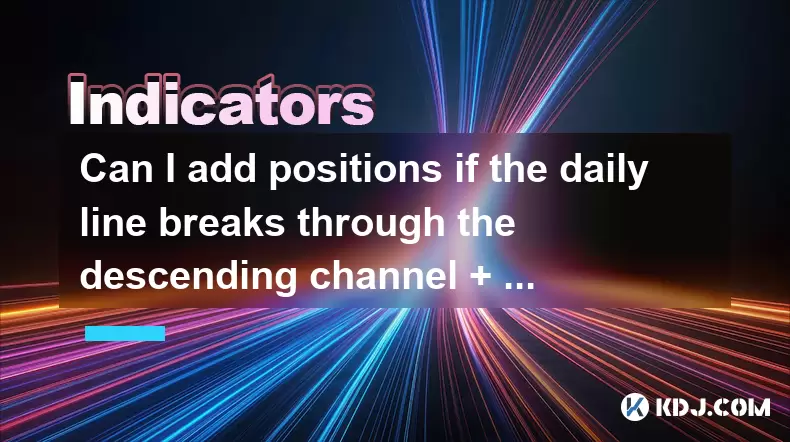
Can I add positions if the daily line breaks through the descending channel + the 30-minute moving average is in a bullish arrangement?
Jun 30,2025 at 11:00pm
Understanding the Descending Channel BreakoutWhen a daily line breaks through a descending channel, it indicates a potential shift in market sentiment from bearish to bullish. A descending channel is formed by drawing two parallel trendlines, where the upper trendline connects the lower highs and the lower trendline connects the lower lows. A breakout o...
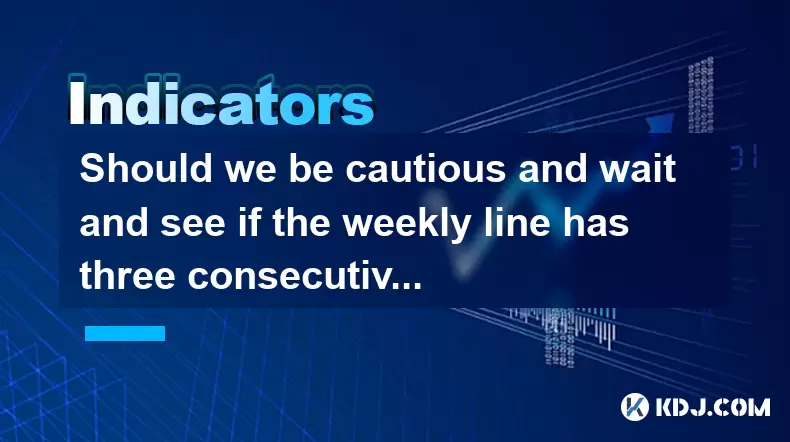
Should we be cautious and wait and see if the weekly line has three consecutive Yin lines + the daily MACD green column enlarges?
Jul 01,2025 at 12:42am
Understanding the Weekly Three Consecutive Yin Lines PatternIn technical analysis, three consecutive Yin lines on a weekly chart indicate a strong bearish trend. Each Yin line represents a week where the closing price is lower than the opening price, signaling consistent selling pressure. When this pattern appears three times in succession, it often sug...
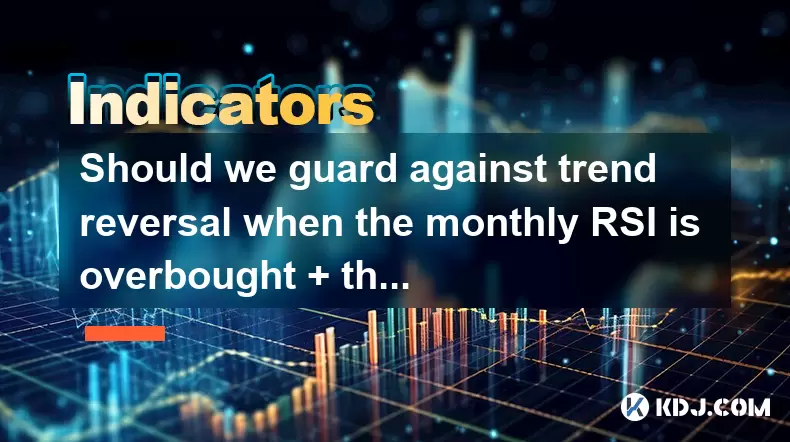
Should we guard against trend reversal when the monthly RSI is overbought + the weekly line has a long upper shadow?
Jun 30,2025 at 11:35pm
Understanding RSI Overbought Conditions in CryptocurrencyThe Relative Strength Index (RSI) is a momentum oscillator commonly used in technical analysis to identify overbought or oversold conditions in an asset. When the monthly RSI of a cryptocurrency reaches above 70, it is generally considered overbought, suggesting that the asset may be due for a pul...
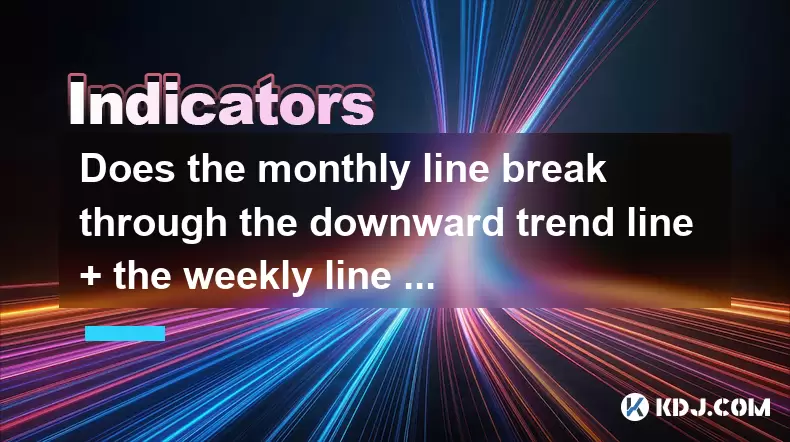
Does the monthly line break through the downward trend line + the weekly line with large volume confirm the reversal?
Jul 01,2025 at 04:49am
Understanding the Monthly Line Breakthrough in CryptocurrencyIn cryptocurrency trading, a monthly line refers to the price movement over a 30-day period represented on a candlestick chart. When this monthly line breaks through a downward trend line, it suggests that the long-term bearish momentum might be weakening. A downward trend line is drawn by con...
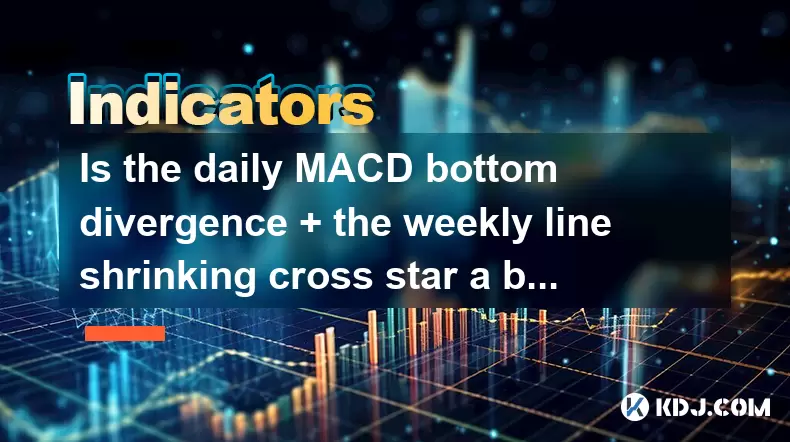
Is the daily MACD bottom divergence + the weekly line shrinking cross star a bottoming signal?
Jul 01,2025 at 03:49am
Understanding MACD Bottom Divergence in Cryptocurrency TradingThe Moving Average Convergence Divergence (MACD) is a widely used technical indicator among cryptocurrency traders to identify potential trend reversals. A bottom divergence occurs when the price of an asset makes a lower low, but the MACD line forms a higher low. This suggests that bearish m...
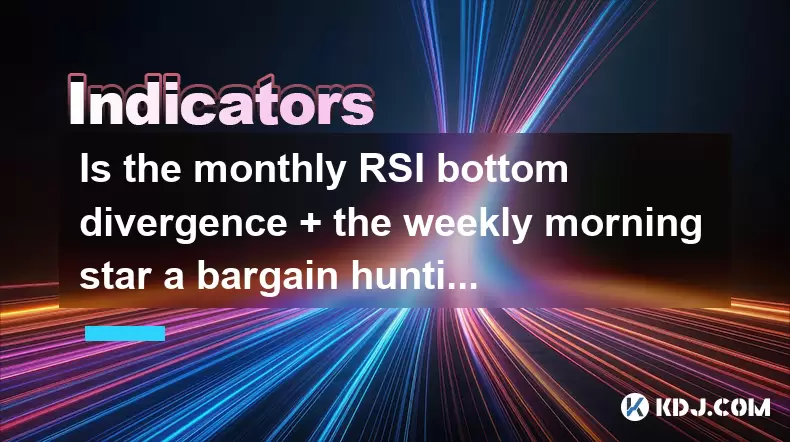
Is the monthly RSI bottom divergence + the weekly morning star a bargain hunting opportunity?
Jun 30,2025 at 09:57pm
Understanding RSI Bottom Divergence in Monthly TimeframesThe Relative Strength Index (RSI) is a momentum oscillator commonly used to identify overbought or oversold conditions in the market. When traders refer to a monthly RSI bottom divergence, they're observing a situation where the price makes a lower low, but the RSI makes a higher low on the monthl...

Can I add positions if the daily line breaks through the descending channel + the 30-minute moving average is in a bullish arrangement?
Jun 30,2025 at 11:00pm
Understanding the Descending Channel BreakoutWhen a daily line breaks through a descending channel, it indicates a potential shift in market sentiment from bearish to bullish. A descending channel is formed by drawing two parallel trendlines, where the upper trendline connects the lower highs and the lower trendline connects the lower lows. A breakout o...

Should we be cautious and wait and see if the weekly line has three consecutive Yin lines + the daily MACD green column enlarges?
Jul 01,2025 at 12:42am
Understanding the Weekly Three Consecutive Yin Lines PatternIn technical analysis, three consecutive Yin lines on a weekly chart indicate a strong bearish trend. Each Yin line represents a week where the closing price is lower than the opening price, signaling consistent selling pressure. When this pattern appears three times in succession, it often sug...

Should we guard against trend reversal when the monthly RSI is overbought + the weekly line has a long upper shadow?
Jun 30,2025 at 11:35pm
Understanding RSI Overbought Conditions in CryptocurrencyThe Relative Strength Index (RSI) is a momentum oscillator commonly used in technical analysis to identify overbought or oversold conditions in an asset. When the monthly RSI of a cryptocurrency reaches above 70, it is generally considered overbought, suggesting that the asset may be due for a pul...

Does the monthly line break through the downward trend line + the weekly line with large volume confirm the reversal?
Jul 01,2025 at 04:49am
Understanding the Monthly Line Breakthrough in CryptocurrencyIn cryptocurrency trading, a monthly line refers to the price movement over a 30-day period represented on a candlestick chart. When this monthly line breaks through a downward trend line, it suggests that the long-term bearish momentum might be weakening. A downward trend line is drawn by con...

Is the daily MACD bottom divergence + the weekly line shrinking cross star a bottoming signal?
Jul 01,2025 at 03:49am
Understanding MACD Bottom Divergence in Cryptocurrency TradingThe Moving Average Convergence Divergence (MACD) is a widely used technical indicator among cryptocurrency traders to identify potential trend reversals. A bottom divergence occurs when the price of an asset makes a lower low, but the MACD line forms a higher low. This suggests that bearish m...

Is the monthly RSI bottom divergence + the weekly morning star a bargain hunting opportunity?
Jun 30,2025 at 09:57pm
Understanding RSI Bottom Divergence in Monthly TimeframesThe Relative Strength Index (RSI) is a momentum oscillator commonly used to identify overbought or oversold conditions in the market. When traders refer to a monthly RSI bottom divergence, they're observing a situation where the price makes a lower low, but the RSI makes a higher low on the monthl...
See all articles

























































































